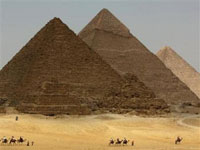|
|

|
|
The Giza pyramids in a file photo. New evidence of a sick, deprived population working under harsh conditions contradicts earlier images of wealth and abundance from the art records of the ancient Egyptian city of Tell el-Amarna, a study has found. [Agencies]
|
New evidence of a sick, deprived population working under harsh conditions contradicts earlier images of wealth and abundance from the art records of the ancient Egyptian city of Tell el-Amarna, a study has found.
Tell el-Amarna was the capital of ancient Egypt during the reign of the pharaoh Akhenaten, who abandoned most of Egypt's old gods in favor of the Aten sun disk and brought in a new and more expressive style of art.
Akhenaten, who ruled Egypt between 1379 and 1362 BC, built and lived in Tell el-Amarna in central Egypt for 15 years. The city was largely abandoned shortly after his death and the ascendance of the famous boy king Tutankhamun to the throne.
Studies on the remains of ordinary ancient Egyptians in a cemetery in Tell el-Amarna showed that many of them suffered from anemia, fractured bones, stunted growth and high juvenile mortality rates, according to professors Barry Kemp and Jerome Rose, who led the research.
Rose, a professor of anthropology in the University of Arkansas in the United States, said adults buried in the cemetery were probably brought there from other parts of Egypt.
"This means that we have a period of deprivation in Egypt prior to the Amarna phase," he said.
"So maybe things were not so good for the average Egyptian and maybe Akhenaten said we have to change to make things better," he said.
Kemp, director of the Amarna Project which seeks in part to increase public knowledge of Tell el-Amarna and surrounding region, said little attention has been given to the cemeteries of ordinary ancient Egyptians.
Rose displayed pictures showing spinal injuries among teenagers, probably because of accidents during construction work to build the city.
The study showed that anemia ran at 74 percent among children and teenagers, and at 44 percent among adults, Rose said. The average height of men was 159 cm (5 feet 2 inches) and 153 cm among women.
"Adult heights are used as a proxy for overall standard of living," he said. "Short statures reflect a diet deficient in protein. ... People were not growing to their full potential."
(Agencies) |
一項考古研究發現,古埃及人健康狀況不佳、生活貧困,勞動條件也很惡劣。這一結論與之前古埃及特拉-埃爾-阿瑪納(簡稱“阿瑪納”)的藝術寶藏向人們展示的豐裕富足的畫面相矛盾。
特拉-埃爾-阿瑪納是阿肯納頓法老統治時期古埃及的都城,阿肯納頓在其統治期間廢止了古埃及的多神崇拜,獨尊太陽神阿頓,并樹立了一種全新的、更具表現力的藝術形式。
阿肯納頓法老統治古埃及的時期為公元前1379年至公元前1362年,他在埃及中部創建了阿瑪納城并在此居住了15年。阿肯納頓去世后,著名的“少年法老”圖坦卡蒙繼位,不久阿瑪納城也幾乎被荒廢。
據研究負責人巴里?凱姆普和杰羅米?羅斯教授介紹,考古人員對阿瑪納一處古埃及普通人的墓中的遺骸進行研究后發現,其中有很多人貧血、骨折、發育遲緩,青少年死亡率也很高。
美國阿肯色大學的人類學教授羅斯說,這處墓地中所埋的成年人有可能來自埃及其它地區。
他說:“這就說明在古埃及的阿瑪納時期前還有一個人民生活貧苦的歷史時期。”
“當時古埃及普通人的生活狀況可能不如人意,所以阿肯納頓法老可能就做出了改革的決定。”
“阿瑪納考古項目”的負責人凱姆普說,之前對于古埃及普通人的墓關注太少。開展“阿瑪納考古項目”一部分就是為了加深人們對阿瑪納以及周邊地區的了解。
羅斯展示了古埃及青少年脊柱受傷的一些照片,這可能是他們在建造阿瑪納城時發生事故受的傷。
研究顯示,古埃及兒童和青少年患貧血的比例為74%,成年人為44%;古埃及男子的平均身高為159厘米,女性為153厘米。
羅斯說:“成年人身高為衡量人們總體生活水平的重要指標。身材矮小說明人們飲食中的蛋白質攝入量不足,從而會導致生長發育不完全。”
點擊查看更多雙語新聞
(英語點津姍姍編輯)
|